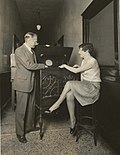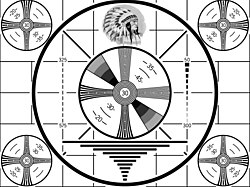Television
A television set (also known as a television receiver or televisor or simply a television, TV set, TV receiver or TV) is a machine with a screen or set of lenses. Televisions receive broadcasting signals and change them into pictures and sound. The word "television" comes from the words tele (far away) and vision (sight).
Sometimes a television can look like a box. Older TVs had a large cathode ray tube in a large wooden frame and sat on the floor like furniture. Newer TVs are much lighter and flatter.
A TV can show pictures from many television networks. Computers and mobile devices also can be used for watching television programs.
The television was invented in the 1920s but the equipment was expensive and the pictures were poor. By the 1950s, these problems had been fixed and TVs became widespread.
At first, all televisions used an antenna (or aerial). This would pick up television programmes from broadcasting stations. A TV station could be many miles or kilometers away, and still be received. TVs can also show movies from VCD and DVD players or VCRs. Cable TV and Satellite television can provide more programs at once than broadcast can. Video game consoles connect to most modern TVs. Some computers can also use a TV as a computer monitor.
All TVs have screens where the picture is viewed. Before the 1950s these were usually "black and white", which made everything look grey, but all modern TVs show colors. Most 20th century screens also had rounded corners. That is because television screens were cathode ray tubes. These are like heavy glass jars with one side bulging out to form the screen.
Today flat panel displays are the usual kind. These are usually flat rectangles with straight edges. This long rectangle looks more like the shape of a movie theatre screen. This is called widescreen. If a widescreen set was 30 cm tall, it would be 53 cm wide. For this to work best, TV shows also need to be made in widescreen. Widescreen sets can still be any size, but they have the same widescreen shape.
The early 21st century is also when digital television transmission became more common than analog television.
Also see
This section needs expansion.
Television Media
Flat-screen television receivers on display for sale at a consumer electronics store in 2008
The Nipkow disk. This schematic shows the circular paths traced by the holes that may also be square for greater precision. The area of the disk outlined in black displays the region scanned.
Baird in 1925 with his televisor equipment and dummies "James" and "Stooky Bill" (right)
Vladimir Zworykin demonstrates electronic television (1929).
Manfred von Ardenne in 1933
Indian-head test pattern used during the black-and-white era before 1970. It was displayed when a television station first signed on every day.
Color bars used in a test pattern, sometimes used when no program material is available
References
| Wikimedia Commons has media related to Lua error in Module:Commons_link at line 62: attempt to index field 'wikibase' (a nil value).. |











